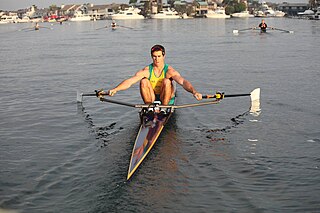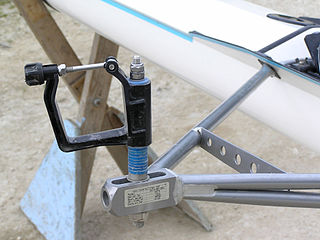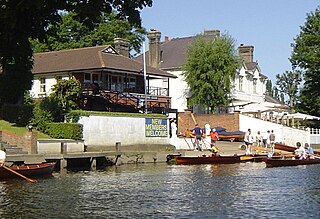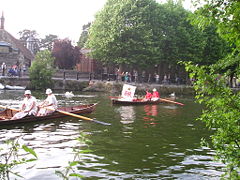
Sculling is the use of oars to propel a boat by moving them through the water on both sides of the craft, or moving one oar over the stern. A long, narrow boat with sliding seats, rigged with two oars per rower may be referred to as a scull, its oars may be referred to as sculls and a person rowing it referred to as sculler.

Clinker built is a method of boat building in which the edges of hull planks overlap each other. Where necessary in larger craft, shorter planks can be joined end to end, creating a longer strake or hull plank.

Rowing is the act of propelling a human-powered watercraft using the sweeping motions of oars to displace water and generate reactional propulsion. Rowing is functionally similar to paddling, but rowing requires oars to be mechanically attached to the boat, and the rower drives the oar like a lever, exerting force in the same direction as the boat's travel; while paddles are completely hand-held and have no attachment to the boat, and are driven like a cantilever, exerting force opposite to the intended direction of the boat.
In competitive rowing, the following specialized terms are important in the corresponding aspects of the sport:

A rowlock, sometimes spur, oarlock or gate, is a brace that attaches an oar to a boat. When a boat is rowed, the rowlock acts as a fulcrum for the oar.
A skiff is any of a variety of essentially unrelated styles of small boats. Traditionally, these are coastal craft or river craft used for leisure, as a utility craft, and for fishing, and have a one-person or small crew. Sailing skiffs have developed into high performance competitive classes. Many of today's skiff classes are based in Australia and New Zealand in the form of 12 ft (3.66 m), 13 ft (3.96 m), 16 ft (4.88 m) and 18 ft (5.49 m) skiffs. The 29er, 49er, SKUD and Musto Skiff are all considered to have developed from the skiff concept, all of which are sailed internationally.

A punt is a flat-bottomed boat with a square-cut bow, designed for use in small rivers and shallow water. Punting is boating in a punt; the punter propels the punt by pushing against the river bed with a pole. Punts were originally built as cargo boats and as platforms for fowling and for fishing, such as angling; whereas now punting is boating for pleasure.

Harry Clasper was a professional rower and boat builder from Tyneside in England. He was an innovative boat designer who pioneered the development of the racing shell and the use of outriggers. He is said to have invented spoon-shaped oars.

A single scull, abbreviated as a 1x, is a racing shell designed for a single person who propels the boat with two oars, one in each hand.

Skiffing refers to the sporting and leisure activity of rowing a Thames skiff. The skiff is a traditional hand built clinker-built wooden craft of a design which has been seen on the River Thames and other waterways in England and other countries since the 19th century. Sculling is the act of propelling the boat with a pair of oars, as opposed to rowing which requires both hands on a single oar.
Boats used in the sport of rowing may be adjusted in many different ways according to the needs of the crew, the type of racing, and anticipated rowing conditions. The primary objective of rigging a boat is to accommodate the different physiques and styles of rowing of the crew in such a way that the oars move in similar arcs through the water, thus improving the crew's efficiency and cohesiveness.
The Thames is one of the main rowing rivers in Europe. Several annual competitions are held along its course, including the Henley Royal Regatta, the The Boat Race and other long-distance events, called Head of the River races (Heads).
The Skiff Club is the oldest skiff and punting club in existence, having been founded in 1895. It is based on the River Thames in London, on the Middlesex bank between Teddington Lock and Kingston upon Thames.

Thames Valley Skiff Club is an English skiff and punting club, which was founded in 1923. It is based on the River Thames in England, on the Surrey bank between Sunbury Lock and Walton on Thames.

Wraysbury Skiff and Punting Club (WSPC) is an English skiff and punting club founded in 1931 based on the River Thames at the start of the Surrey section of the right bank – between the rest of Runnymede and Bell Weir Lock.

Dittons Skiff and Punting Club (DSPC or Dittons) is an English skiff and punting club, which was founded in 1923. It is based on the River Thames with a club and boat house at Thames Ditton on the reach above Teddington Lock. As well as taking part in regular skiff and punt racing competitions, crews from the club have established several rowing world records.

A double scull, also abbreviated as a 2x, is a rowing boat used in the sport of competitive rowing. It is designed for two persons who propel the boat by sculling with two oars each, one in each hand.

An octuple sculling shell, often simply called an oct and abbreviated as an 8x or 8x+, is a racing shell used in the sport of rowing.

Human-powered watercraft are watercraft propelled only by human power, instead of being propelled by wind power or an engine.

Stern sculling is the use of a single oar over the stern of a boat to propel it with side-to-side motions that create forward lift in the water. It is distinguished from sculling, which is rowing with two oars on either side of the boat and from sweep rowing, whereby each boat crew member employs a single oar, complemented by another crew member on the opposite side with an oar, usually with each pulling an oar with two hands.
















